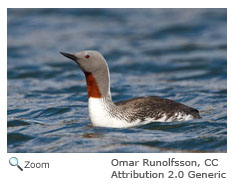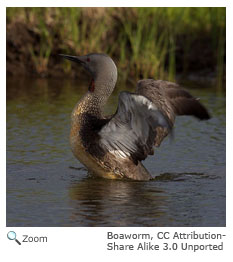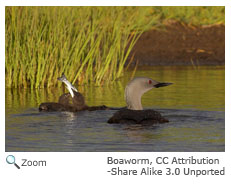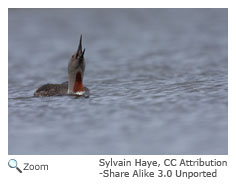Description
 The Red-throated Loon is the smallest of the loons and changes color throughout the year. During the summer, its head and neck are grey with a large glossy red patch on its neck. During winter, the Red-throated Loon's head turns white and the red patch goes away for the season. While swimming, the loon sits very low in the water; often just its head and neck is above water. The Red-throated Loon is the smallest of the loons and changes color throughout the year. During the summer, its head and neck are grey with a large glossy red patch on its neck. During winter, the Red-throated Loon's head turns white and the red patch goes away for the season. While swimming, the loon sits very low in the water; often just its head and neck is above water.
Range
Spending most of its time in the arctic, the Red-throated Loon is found in Alaska and throughout Northern Canada. In the summer, it migrates down to central Canada and around the Great Lakes. Occasionally, it appears on the outskirts of northern New England during summer migration. In the winter, the Red-throated Loon lives in the coastal waters off of both North American coasts.
Habitat
 During the breeding season, the Red-throated Loon lives in freshwater ponds, lakes, wetlands and bogs. During migration, flocks of loons often share large lakes. In the winter, the Red-throated Loon lives along sheltered coastlines in salt water. It is sensitive to human disturbance and will leave a body of water if too many humans are near. During the breeding season, the Red-throated Loon lives in freshwater ponds, lakes, wetlands and bogs. During migration, flocks of loons often share large lakes. In the winter, the Red-throated Loon lives along sheltered coastlines in salt water. It is sensitive to human disturbance and will leave a body of water if too many humans are near.
|
|
Diet
 The Red-throated Loon only hunts in marine waters, never in the freshwater ponds and lakes used for nesting. It locates prey visually, needing clear water to find fish as they swim by. The Red-throated Loon dives to retrieve its food, which is mostly small to medium-sized fish. It sometimes eats crustaceans, mollusks, frogs, fish eggs and insects. The Red-throated Loon only hunts in marine waters, never in the freshwater ponds and lakes used for nesting. It locates prey visually, needing clear water to find fish as they swim by. The Red-throated Loon dives to retrieve its food, which is mostly small to medium-sized fish. It sometimes eats crustaceans, mollusks, frogs, fish eggs and insects.
Life Cycle
 Breeding begins when the spring thaw occurs, usually in May. The male selects a nesting site close to deep water. The male and female build the nest from a heap of plant material. The female lays two eggs, which are incubated for three weeks by the male and female. After 2 or 3 weeks, the chicks begin swimming and spend most of their time in the water. At this point, they still rely on their parents for food. After 7 weeks, the chicks can fly on their own and are independent from their parents. Breeding begins when the spring thaw occurs, usually in May. The male selects a nesting site close to deep water. The male and female build the nest from a heap of plant material. The female lays two eggs, which are incubated for three weeks by the male and female. After 2 or 3 weeks, the chicks begin swimming and spend most of their time in the water. At this point, they still rely on their parents for food. After 7 weeks, the chicks can fly on their own and are independent from their parents.
Behavior
 Unlike the Common Loon, the Red-throated Loon can take off directly from land or water and does not need a runway. Unlike the Common Loon, the Red-throated Loon can take off directly from land or water and does not need a runway. |





